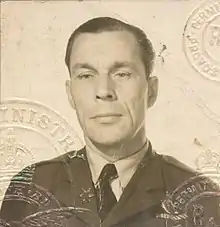Karol Pniak | |
|---|---|
 | |
| Nickname(s) | Cognac (RAF nickname)[1] |
| Born | 26 January 1910 Jaworzno, Poland |
| Died | 10 November 1980 (aged 70) Kraków, Poland |
| Allegiance | |
| Service/ | |
| Service number | 76707 |
| Unit | No. 32 Squadron RAF No. 308 Polish Fighter Squadron |
| Commands held | No. 308 Polish Fighter Squadron (29 November 1944 – 30 June 1945) |
| Battles/wars | Second World War |
Karol Pniak (26 January 1910 – 10 November 1980) was a Polish World War II flying ace of the Battle of Britain. Originally a pilot for the Polish Air Force in the September Campaign of 1939, he later flew with No. 32 Squadron of the Royal Air Force, during the Battle of Britain, where he was known by the nickname "Cognac."[1] Karol Pniak claimed five victories in the Battle.
Pilot Officer Pniak then served with 257 Squadron, and was involved in the dogfight with Regia Aeronautica aircraft on 11 November 1940. He attacked one Fiat BR.20M bomber that began to smoke and burn and then turned onto its back before it dived into the North Sea 10 miles east of Harwich after one man had baled out. He then attacked another, which glided in towards the coast, trailing smoke.
Pniak then transferred to 306 Squadron, serving from November 1940 to November 1941. Two months at the Air Fighting Development Unit followed, before a return to 306 until January 1943.
Pniak then served for five months in North Africa with the Polish Fighting Team. From September 1943 to November 1944 he was an instructor at No. 6 Operational Training Unit. From 29 November 1944 until 30 June 1945 he commanded No. 308 "Cracow" Squadron[2]
After the war he was assigned to Headquarters, Polish Air Force in July 1945 and the Polish No. 131 Wing in November 1945. In August 1946 he returned to 308 Squadron as a supernumerary commander, receiving a Bar to his Polish Cross of Valour and Dutch Airman's Cross.
Pniak's final tally was 7 aircraft claimed destroyed, 2 shared destroyed, 2 "probables", 1 damaged, with 2 shared damaged.
He left active service in 1947 and returned to Poland, where he died in Kraków in 1980.
References
- 1 2 Gretzyngier, Robert (1998). Polish Aces of World War 2. Osprey Aircraft of the Aces No 21. London: Osprey. ISBN 1855327260. p. 21.
- ↑ Król, Wacław (1976). Polskie dywizjony lotnicze w Wielkiej Brytanii, 1940-1945. Warsaw: Wydawn. Ministerstwa Obrony Narodowe. p. 305. (in Polish)
Further reading
- Tadeusz Jerzy Krzystek, Anna Krzystek: Polskie Siły Powietrzne w Wielkiej Brytanii w latach 1940-1947 łącznie z Pomocniczą Lotniczą Służbą Kobiet (PLSK-WAAF). Sandomierz: Stratus, 2012, s. 459. ISBN 9788361421597
- Jerzy Pawlak: Absolwenci Szkoły Orląt: 1925-1939. Warszawa: Retro-Art, 2009, s. 215. ISBN 8387992224
- Piotr Sikora: Asy polskiego lotnictwa. Warszawa: Oficyna Wydawnicza Alma-Press. 2014, s. 296–303. ISBN 9788370205607
- Józef Zieliński: Asy polskiego lotnictwa. Warszawa: Agencja lotnicza ALTAIR, 1994, s. 45. ISBN 83862172.
- Józef Zieliński: Lotnicy polscy w Bitwie o Wielką Brytanię. Warszawa: Oficyna Wydawnicza MH, 2005, s. 169–170. ISBN 8390662043
External links
Polish